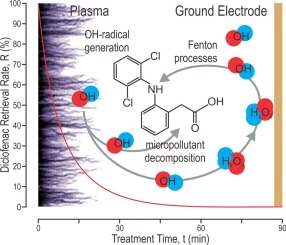当前位置:
X-MOL 学术
›
J. Hazard. Mater.
›
论文详情
Our official English website, www.x-mol.net, welcomes your
feedback! (Note: you will need to create a separate account there.)
Degradation and Intermediates of Diclofenac as Instructive Example for Decomposition of Recalcitrant Pharmaceuticals by Hydroxyl Radicals Generated with Pulsed Corona Plasma in Water
Journal of Hazardous Materials ( IF 12.2 ) Pub Date : 2017-08-25 , DOI: 10.1016/j.jhazmat.2017.08.058 Robert Banaschik , Helena Jablonowski , Patrick J. Bednarski , Juergen F. Kolb
Journal of Hazardous Materials ( IF 12.2 ) Pub Date : 2017-08-25 , DOI: 10.1016/j.jhazmat.2017.08.058 Robert Banaschik , Helena Jablonowski , Patrick J. Bednarski , Juergen F. Kolb

|
Seven recalcitrant pharmaceutical residues (diclofenac, 17α-ethinylestradiol, carbamazepine, ibuprofen, trimethoprim, diazepam, diatrizoate) were decomposed by pulsed corona plasma generated directly in water. The detailed degradation pathway was investigated for diclofenac and 21 intermediates could be identified in the degradation cascade. Hydroxyl radicals have been found primarily responsible for decomposition steps. By spin trap enhanced electron paramagnetic resonance spectroscopy (EPR), OH-adducts and superoxide anion radical adducts were detected and could be distinguished applying BMPO as a spin trap. The increase of concentrations of adducts follows qualitatively the increase of hydrogen peroxide concentrations. Hydrogen peroxide is eventually consumed in Fenton-like processes but the concentration is continuously increasing to about 2 mM for a plasma treatment of 70 minutes. Degradation of diclofenac is inversely following hydrogen peroxide concentrations. No qualitative differences between byproducts formed during plasma treatment or due to degradation via Fenton-induced processes were observed. Findings on degradation kinetics of diclofenac provide an instructive understanding of decomposition rates for recalcitrant pharmaceuticals with respect to their chemical structure. Accordingly, conclusions can be drawn for further development and a first risk assessment of the method which can also be applied towards other AOPs that rely on the generation of hydroxyl radicals.
中文翻译:

双氯芬酸的降解及其中间体,作为脉冲电晕等离子体在水中产生的羟基自由基分解难降解药物的说明性实例
直接在水中产生的脉冲电晕等离子体分解了七个顽强的药物残留物(双氯芬酸,17α-炔雌醇,卡马西平,布洛芬,甲氧苄啶,地西epa,泛影酸盐)。研究了双氯芬酸的详细降解途径,可以在降解级联反应中鉴定出21种中间体。已经发现羟基自由基主要负责分解步骤。通过自旋陷阱增强电子顺磁共振波谱(EPR),可以检测到OH加合物和超氧阴离子自由基加合物,并可以将BMPO作为自旋阱加以区分。加合物浓度的增加在质量上跟随过氧化氢浓度的增加。最终,过氧化氢以类Fenton的方式被消耗,但对于70分钟的等离子体处理,其浓度不断增加至约2 mM。双氯芬酸的降解与过氧化氢浓度成反比。没有观察到在等离子体处理期间形成的副产物之间或由于芬顿诱导的过程的降解所引起的副产物之间的质量差异。关于双氯芬酸降解动力学的发现,对于顽固性药物的化学结构,提供了有益的理解。因此,
更新日期:2017-08-26
中文翻译:

双氯芬酸的降解及其中间体,作为脉冲电晕等离子体在水中产生的羟基自由基分解难降解药物的说明性实例
直接在水中产生的脉冲电晕等离子体分解了七个顽强的药物残留物(双氯芬酸,17α-炔雌醇,卡马西平,布洛芬,甲氧苄啶,地西epa,泛影酸盐)。研究了双氯芬酸的详细降解途径,可以在降解级联反应中鉴定出21种中间体。已经发现羟基自由基主要负责分解步骤。通过自旋陷阱增强电子顺磁共振波谱(EPR),可以检测到OH加合物和超氧阴离子自由基加合物,并可以将BMPO作为自旋阱加以区分。加合物浓度的增加在质量上跟随过氧化氢浓度的增加。最终,过氧化氢以类Fenton的方式被消耗,但对于70分钟的等离子体处理,其浓度不断增加至约2 mM。双氯芬酸的降解与过氧化氢浓度成反比。没有观察到在等离子体处理期间形成的副产物之间或由于芬顿诱导的过程的降解所引起的副产物之间的质量差异。关于双氯芬酸降解动力学的发现,对于顽固性药物的化学结构,提供了有益的理解。因此,











































 京公网安备 11010802027423号
京公网安备 11010802027423号